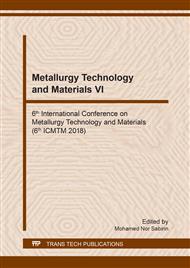[1]
D. D. L. Chung, Exfoliation of graphite, Mater. Sci. 22 (1987) 4190-4198.
Google Scholar
[2]
D. D. L. Chung, A review of exfoliated graphite, J. Mater. Sci. 51 (2016) 554-568.
Google Scholar
[3]
S.R. Dhakate, N. Chauhan, S. Sharma, An approach to produce single and double layer grapheme from re-exfoliation of expanded graphite, Carbon 49(2011)1946-(1954).
DOI: 10.1016/j.carbon.2010.12.068
Google Scholar
[4]
X.S. Du, M. Xiao, Y.Z. Meng, A.S. Hay, Facile synthesis of exfoliated and highly conductive poly (arylene disulfide)/graphite nanocomposites, Polym. Adv. Technol. 15 (2004) 320-323.
DOI: 10.1002/pat.457
Google Scholar
[5]
C. Minzhen, T.D. Daniel, H. Adamson, H.C. Schniepp, Methods of graphite exfoliation, J. Mater. Chem. 22 (2012) 24992-25002.
Google Scholar
[6]
J. Park, W. C. Mitchel, L. Grazulis, H. E. Smith, K. G. Eyink, J. J. Boeckl, D. H. Tomich, S. D. Pacley, and J. E. Hoelscher, Epitaxial graphene growth by Carbon Molecular Beam Epitaxy (CMBE), Adv. Mater., 22 (2010) 4140-4145.
DOI: 10.1002/adma.201000756
Google Scholar
[7]
J. T. Li, M. Li, J. H. Li, and H. W. Sun, Decolorization of azo dye direct scarlet 4BS solution using exfoliated graphite under ultrasonic irradiation, Ultrason. Sonochem., 14 (2007) 241-245.
DOI: 10.1016/j.ultsonch.2006.04.005
Google Scholar
[8]
A. Yasmin, J.J. Luo, I.M. Daniel, Processing of expanded graphite reinforced polymer nanocomposites, Compos. Sci. Technol. 66 (2006) 1179–1186.
Google Scholar
[9]
N. Petrone, C. R. Dean, I. Meric, A. M. Van Der Zande, P. Y. Huang, L. Wang, D. Muller, K. L. Shepard, and J. Hone, Chemical vapor deposition-derived graphene with electrical performance of exfoliated graphene, Nano Lett., 12 (2012) 2751-2756.
DOI: 10.1021/nl204481s
Google Scholar
[10]
N. Sykam and K. K. Kar, Rapid synthesis of exfoliated graphite by microwave irradiation and oil sorption studies, Mater. Lett., 117 (2017) 150-152.
DOI: 10.1016/j.matlet.2013.12.003
Google Scholar
[11]
G. Wang, Q. Sun, Y. Zhang, J. Fan, and L. Ma, Sorption and regeneration of magnetic exfoliated graphite as a new sorbent for oil pollution,, Desalination, 263 (2010) 183-188.
DOI: 10.1016/j.desal.2010.06.056
Google Scholar
[12]
B. Tryba, A. W. Morawski, R. J. Kaleńczuk, and M. Inagaki, Exfoliated graphite as a new sorbent for removal of engine oils from wastewater, Spill Sci. Technol. Bull., 8 (2003) 569 - 571.
DOI: 10.1016/s1353-2561(03)00070-7
Google Scholar
[13]
T. Wei, Z. Fan, G. Luo, C. Zheng, and D. Xie, A rapid and efficient method to prepare exfoliated graphite by microwave irradiation, Carbon, 47 (2009) 337-339.
DOI: 10.1016/j.carbon.2008.10.013
Google Scholar
[14]
B. Tryba, A. W. Morawski, and M. Inagaki, Preparation of exfoliated graphite by microwave irradiation, Carbon N. Y., 43 (2005) 2417-2419.
DOI: 10.1016/j.carbon.2005.04.017
Google Scholar
[15]
Y. Kun, Preparation of exfoliated graphite by microwave using natural graphite preparation of exfoliated graphite by microwave using natural graphite, Adv. Mat. Res. 163 (2011) 2333-2336.
DOI: 10.4028/www.scientific.net/amr.163-167.2333
Google Scholar


